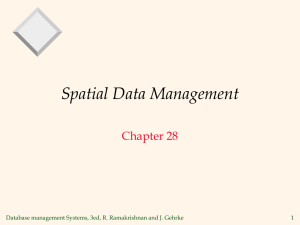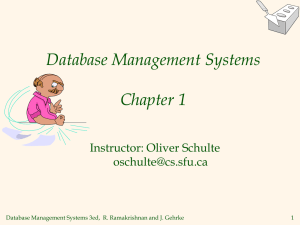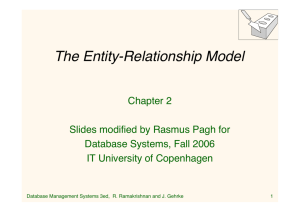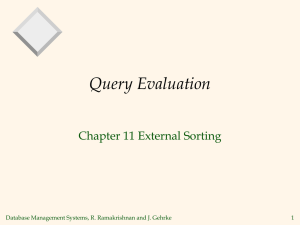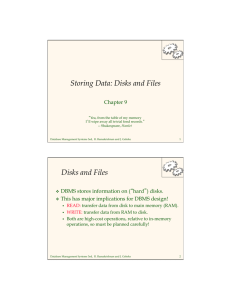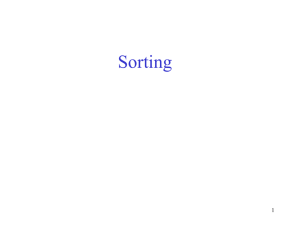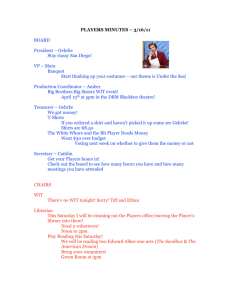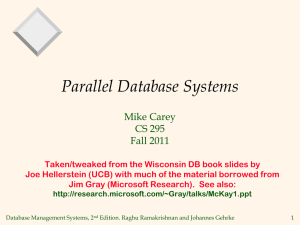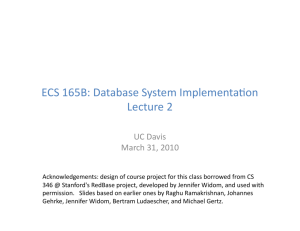MYCH7 - Computing Science
advertisement
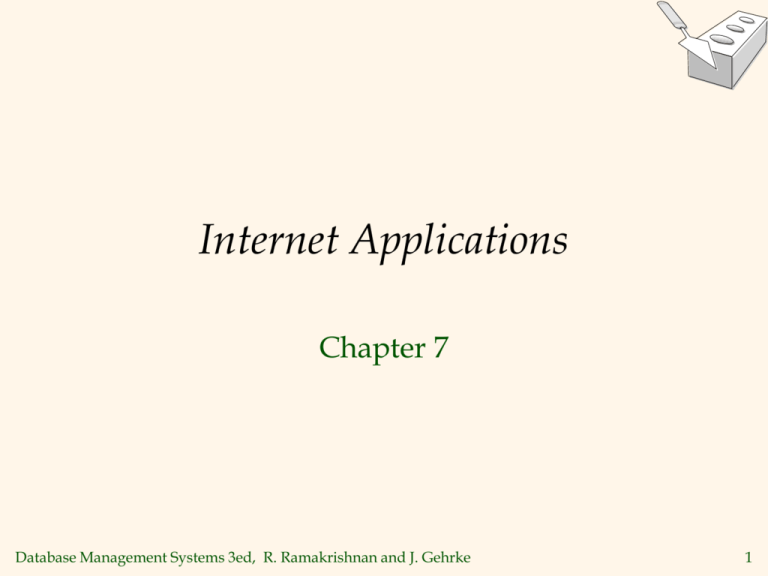
Internet Applications
Chapter 7
Database Management Systems 3ed, R. Ramakrishnan and J. Gehrke
1
Lecture Overview
Internet Concepts: Data Flow from Client to
DBMS
Introduction to three-tier architectures
Web data formats
HTML, XML, DTDs
The presentation layer
HTML forms; Javascript; Stylesheets
The middle tier
CGI, application servers, passing arguments,
maintaining state (cookies)
Database Management Systems 3ed, R. Ramakrishnan and J. Gehrke
2
Components of Data-Intensive
Systems
Three separate types of functionality:
Data management
Application logic
Presentation
The system architecture determines whether
these three components reside on a single
system (“tier) or are distributed across several
tiers
Database Management Systems 3ed, R. Ramakrishnan and J. Gehrke
3
Architecture Overview
Database Management Systems 3ed, R. Ramakrishnan and J. Gehrke
4
Process/Data Flow in Network
Enters request
User/Client
Sends query
Application
Returns results
Database
Returns data
Database Management Systems 3ed, R. Ramakrishnan and J. Gehrke
5
Example: Course Enrolment
Enters request: add
course, drop course
User/Client
Sends query: Course
availability, student info,…
Application
• Checks constraints
• returns confirmation
for display
Database
Returns data
Database Management Systems 3ed, R. Ramakrishnan and J. Gehrke
6
Example: Airline Reservation System
Enters request: log
in, show seat map
User/Client
Sends query: Airline info,
available seats, customer info…
Application
Returns results: map
data for display,
confirmation
Database
Returns data
Database Management Systems 3ed, R. Ramakrishnan and J. Gehrke
7
Example: Book Order System
• Sends query: List books,
customer info,…
• maintains shopping cart
Enters request:
search for book
User/Client
Application
Returns results:
requested data,
recommendations,
order information.
Database
Returns data
Database Management Systems 3ed, R. Ramakrishnan and J. Gehrke
8
Client-Server Architectures
Work division: Thin client
Client implements only the
graphical user interface
Server implements business
logic and data management.
Development supported by
Visual Studio, Sybase
Powerbuilder.
Work division: Thick client
Client implements both the
graphical user interface and the
business logic
Server implements data
management
Database Management Systems 3ed, R. Ramakrishnan and J. Gehrke
9
Discussion Question
What are advantages of thin clients?
What are disadvantages of thin clients?
What are advantages of thick clients?
What are disadvantages of thick clients?
Database Management Systems 3ed, R. Ramakrishnan and J. Gehrke
10
Client-Server Architectures
Disadvantages of thick clients
No central place to update the business logic
Security issues: Server needs to trust clients
• Access control and authentication needs to be managed at
the server
• Clients need to leave server database in consistent state
Does not scale to more than several 100s of clients
• Large data transfer between server and client
• More than one server creates a problem: x clients, y
servers: x*y connections
Database Management Systems 3ed, R. Ramakrishnan and J. Gehrke
11
The Three-Tier Architecture
Presentation tier
Middle tier
Data management
tier
Client Program (Web Browser)
Application Server
Database System
Database Management Systems 3ed, R. Ramakrishnan and J. Gehrke
C
l
o
u
d
12
Example 1: Airline reservations
Build a system for making airline reservations
What is done in the different tiers?
Database System
Airline info, available seats, customer info, etc.
Application Server
Logic to make reservations, cancel reservations,
add new airlines, etc.
Client Program
Log in different users, display forms and humanreadable output
Database Management Systems 3ed, R. Ramakrishnan and J. Gehrke
13
Example 2: Course Enrollment
Build a system for students to enroll in courses
Database System
Student info, course info, instructor info, course
availability, pre-requisites, etc.
Application Server
Logic to add a course, drop a course, create a new
course, etc.
Client Program
Log in different users (students, staff, faculty),
display forms and human-readable output
Database Management Systems 3ed, R. Ramakrishnan and J. Gehrke
14
The Three Layers
Presentation tier
Primary interface to the user
Needs to adapt to different display devices (PC, PDA, cell
phone, voice access?)
Middle tier
Implements business logic (implements complex actions,
maintains state between different steps of a workflow)
Accesses different data management systems
Data management tier
One or more standard database management systems
Database Management Systems 3ed, R. Ramakrishnan and J. Gehrke
15
Advantages of the Three-Tier
Architecture
Heterogeneous systems
Tiers can be independently maintained, modified, and replaced
Thin clients
Only presentation layer at clients (web browsers)
Integrated data access
Several database systems can be handled transparently at the middle
tier
Central management of connections
Scalability
Replication at middle tier permits scalability of business logic
Software development
Code for business logic is centralized
Interaction between tiers through well-defined APIs: Can reuse
standard components at each tier
Database Management Systems 3ed, R. Ramakrishnan and J. Gehrke
16
Discussion Question
Do mobile devices follow the 3-tier
architecture?
If not, does this cause problems?
Database Management Systems 3ed, R. Ramakrishnan and J. Gehrke
17
Technologies
Client Program
(Web Browser)
Application Server
(Tomcat, Apache)
Database System
(DB2)
Database Management Systems 3ed, R. Ramakrishnan and J. Gehrke
HTML
Javascript
JSP
Servlets
Cookies
CGI
XML
Stored Procedures
18
Presentation Layer
HTTP
Database Management Systems 3ed, R. Ramakrishnan and J. Gehrke
19
Overview of the Presentation Tier
Functionality of the presentation tier
Primary interface to the user
Needs to adapt to different display devices (PC,
PDA, cell phone, voice access?)
Simple functionality, such as field validity checking
We will cover:
Http protocol.
XML, HTML Forms: How to pass data to the middle
tier
JavaScript: Simple functionality at the presentation
tier.
Database Management Systems 3ed, R. Ramakrishnan and J. Gehrke
20
Uniform Resource Identifiers
Uniform naming schema to identify resources on the
Internet
A resource can be anything:
Index.html
mysong.mp3
picture.jpg
Example URIs:
http://www.cs.wisc.edu/~dbbook/index.html
mailto:webmaster@bookstore.com
Database Management Systems 3ed, R. Ramakrishnan and J. Gehrke
21
Structure of URIs
http://www.cs.wisc.edu/~dbbook/index.html
URI has three parts:
Naming schema (http)
Name of the host computer (www.cs.wisc.edu)
Name of the resource (~dbbook/index.html)
URLs are a subset of URIs
Database Management Systems 3ed, R. Ramakrishnan and J. Gehrke
22
Hypertext Transfer Protocol
What is a communication protocol?
Set of standards that defines the structure of messages
Examples: TCP, IP, HTTP
What happens if you click on
www.cs.wisc.edu/~dbbook/index.html?
1.
Client (web browser) sends HTTP request to server
Server receives request and replies
Client receives reply; makes new requests
2.
3.
Database Management Systems 3ed, R. Ramakrishnan and J. Gehrke
23
HTTP (Contd.)
Client to Server:
Server replies:
GET ~/index.html HTTP/1.1
User-agent: Mozilla/4.0
Accept: text/html, image/gif,
image/jpeg
HTTP/1.1 200 OK
Date: Mon, 04 Mar 2002 12:00:00 GMT
Server: Apache/1.3.0 (Linux)
Last-Modified: Mon, 01 Mar 2002
09:23:24 GMT
Content-Length: 1024
Content-Type: text/html
<HTML> <HEAD></HEAD>
<BODY>
<h1>Barns and Nobble Internet
Bookstore</h1>
Our inventory:
<h3>Science</h3>
<b>The Character of Physical Law</b>
...
Database Management Systems 3ed, R. Ramakrishnan and J. Gehrke
24
HTTP Protocol Structure
HTTP Requests
Request line:
GET ~/index.html HTTP/1.1
GET: Http method field (possible values are GET and POST,
more later)
~/index.html: URI field
HTTP/1.1: HTTP version field
Type of client:
User-agent: Mozilla/4.0
What types of files will the client accept:
Accept: text/html, image/gif, image/jpeg
Database Management Systems 3ed, R. Ramakrishnan and J. Gehrke
25
HTTP Protocol Structure (Contd.)
HTTP Responses
Status line: HTTP/1.1 200 OK
HTTP version: HTTP/1.1
Status code: 200
Server message: OK
Common status code/server message combinations:
•
•
•
•
200 OK: Request succeeded
400 Bad Request: Request could not be fulfilled by the server
404 Not Found: Requested object does not exist on the server
505 HTTP Version not Supported
Date when the object was created:
Last-Modified: Mon, 01 Mar 2002 09:23:24 GMT
Number of bytes being sent: Content-Length: 1024
What type is the object being sent: Content-Type: text/html
Other information such as the server type, server time, etc.
Database Management Systems 3ed, R. Ramakrishnan and J. Gehrke
26
HTTP has no states
HTTP is stateless
No sessions
Every message is completely self-contained
No previous interaction is remembered by the protocol – fire
and forget.
Implications for applications:
Any state information (shopping carts, user login-information)
needs to be encoded in every HTTP request and response!
Popular methods on how to maintain state (more later).
• Cookies.
• Dynamically generate unique URL’s.
Database Management Systems 3ed, R. Ramakrishnan and J. Gehrke
27
Web Data Formats
HTML
The presentation language for the Internet
XML
A self-describing, hierarchical data model.
XML Examples and Exercises
And others, e.g. SGML, not covered.
Database Management Systems 3ed, R. Ramakrishnan and J. Gehrke
28
HTML: An Example
<HTML>
<HEAD></HEAD>
<BODY>
<h1>Barns and Nobble Internet
Bookstore</h1>
Our inventory:
<h3>Science</h3>
<b>The Character of Physical
Law</b>
<UL>
<LI>Author: Richard
Feynman</LI>
<LI>Published 1980</LI>
<LI>Hardcover</LI>
</UL>
<h3>Fiction</h3>
<b>Waiting for the Mahatma</b>
<UL>
<LI>Author: R.K. Narayan</LI>
<LI>Published 1981</LI>
</UL>
<b>The English Teacher</b>
<UL>
<LI>Author: R.K. Narayan</LI>
<LI>Published 1980</LI>
<LI>Paperback</LI>
</UL>
</BODY>
</HTML>
Database Management Systems 3ed, R. Ramakrishnan and J. Gehrke
29
HTML: A Short Introduction
HTML is a markup language: for presentation.
Commands are tags:
Start tag and end tag
Examples:
• <HTML> … </HTML>
• <UL> … </UL>
Many editors automatically generate HTML
directly from your document.
Database Management Systems 3ed, R. Ramakrishnan and J. Gehrke
30
HTML: Sample Commands
<HTML>:
<UL>: unordered list
<LI>: list entry
<h1>: largest heading
<h2>: second-level heading, <h3>, <h4>
analogous
<B>Title</B>: Bold
Database Management Systems 3ed, R. Ramakrishnan and J. Gehrke
31
HTML Forms
Common way to communicate data from client to
middle tier
General format of a form:
<FORM ACTION=“page.jsp” METHOD=“GET”
NAME=“LoginForm”>
…
</FORM>
Components of an HTML FORM tag:
ACTION: Specifies URI that handles the content
METHOD: Specifies HTTP GET or POST method
NAME: Name of the form; can be used in client-side scripts to
refer to the form
Database Management Systems 3ed, R. Ramakrishnan and J. Gehrke
48
Inside HTML Forms
INPUT tag
Attributes:
• TYPE: text (text input field), password (text input field where
input is, reset (resets all input fields)
• NAME: symbolic name, used to identify field value at the middle
tier
• VALUE: default value
Example: <INPUT TYPE=“text” Name=“title”>
Example form:
<form method="POST" action="TableOfContents.jsp">
<input type="text" name="userid">
<input type="password" name="password">
<input type="submit" value="Login“ name="submit">
<input type=“reset” value=“Clear”>
</form>
Database Management Systems 3ed, R. Ramakrishnan and J. Gehrke
49
Passing Arguments
Two methods: GET and POST
Form contents go into URI
Structure:
action?name1=value1&name2=value2&name3=value3
Action: name of the URI specified in the form
(name,value)-pairs come from INPUT fields in the
form; empty fields have empty values (“name=“)
Example from previous password form:
TableOfContents.jsp?userid=john&password=johnpw
Action needs to refer to a program, script, or page that
will process the user input
Database Management Systems 3ed, R. Ramakrishnan and J. Gehrke
50
HTML Forms: A Complete Example
<form method="POST" action="TableOfContents.jsp">
<table align = "center" border="0" width="300">
<tr>
<td>Userid</td>
<td><input type="text" name="userid" size="20"></td>
</tr>
<tr>
<td>Password</td>
<td><input type="password" name="password" size="20"></td>
</tr>
<tr>
<td align = "center"><input type="submit" value="Login“
name="submit"></td>
</tr>
</table>
</form>
Database Management Systems 3ed, R. Ramakrishnan and J. Gehrke
52
JavaScript
Goal: Add functionality to the presentation tier.
Sample applications:
Detect browser type and load browser-specific page
Form validation: Validate form input fields
Browser control: Open new windows, close existing windows
(example: pop-up ads)
Usually embedded directly inside the HTML with the
<SCRIPT> … </SCRIPT> tag.
<SCRIPT> tag has several attributes:
LANGUAGE: specifies language of the script (such as
javascript)
SRC: external file with script code
Example:
<SCRIPT LANGUAGE=“JavaScript” SRC=“validate.js>
</SCRIPT>
Database Management Systems 3ed, R. Ramakrishnan and J. Gehrke
53
JavaScript (Contd.)
JavaScript is a complete scripting language
Variables
Assignments (=, +=, …)
Comparison operators (<,>,…), boolean operators
(&&, ||, !)
Statements
• if (condition) {statements;} else {statements;}
• for loops, do-while loops, and while-loops
Functions with return values
• Create functions using the function keyword
• f(arg1, …, argk) {statements;}
Database Management Systems 3ed, R. Ramakrishnan and J. Gehrke
55
JavaScript: A Complete Example
HTML Form:
Associated JavaScript:
<form method="POST“
action="TableOfContents.jsp">
<input type="text"
name="userid">
<input type="password"
name="password">
<input type="submit"
value="Login“
name="submit">
<input type=“reset”
value=“Clear”>
</form>
<script language="javascript">
function testLoginEmpty()
{
loginForm = document.LoginForm
if ((loginForm.userid.value == "") ||
(loginForm.password.value == ""))
{
alert('Please enter values for userid and
password.');
return false;
}
else return true;
}
</script>
Database Management Systems 3ed, R. Ramakrishnan and J. Gehrke
56
Middle Layer
Application Logic
Database Management Systems 3ed, R. Ramakrishnan and J. Gehrke
58
Overview of the Middle Tier
Functionality of the middle tier
Encodes business logic
Connects to database system(s)
Accepts form input from the presentation tier
Generates output for the presentation tier
We will cover
CGI: Protocol for passing arguments to programs running at
the middle tier
Application servers: Runtime environment at the middle tier
Maintaining state: How to maintain state at the middle tier.
Main focus: Cookies.
Database Management Systems 3ed, R. Ramakrishnan and J. Gehrke
59
CGI: Common Gateway Interface
Transmits arguments from HTML forms to application
programs running at the middle tier
Details of the actual CGI protocol unimportant
libraries implement high-level interfaces
Example: Implementing a wiki.
The user agent requests the name of an entry.
The server retrieves the source of that entry's page.
Transforms it into HTML
Sends the result.
Database Management Systems 3ed, R. Ramakrishnan and J. Gehrke
61
CGI: Example
HTML form:
<form action=“findbooks.cgi” method=POST>
Type an author name:
<input type=“text” name=“authorName”>
<input type=“submit” value=“Send it”>
<input type=“reset” value=“Clear form”>
</form>
Perl code:
use CGI;
$dataIn=new CGI;
$dataIn->header();
$authorName=$dataIn->param(‘authorName’);
print(“<HTML><TITLE>Argument passing test</TITLE>”);
print(“The author name is “ + $authorName);
print(“</HTML>”);
exit;
Database Management Systems 3ed, R. Ramakrishnan and J. Gehrke
62
CGI Disadvantages
Disadvantages:
Each CGI script invocation leads to a new process.
No resource sharing between application programs
(e.g., database connections)
Remedy: Application servers share treads in
process.
Database Management Systems 3ed, R. Ramakrishnan and J. Gehrke
63
Application Servers
Idea: Avoid the overhead of CGI
Main pool of threads inside processes.
Requests are assigned to threads (cheap) rather than
separate processes.
Manage connections
Enable access to heterogeneous data sources
Other functionality such as APIs for session
management.
Servlets handle client requests using Java.
Database Management Systems 3ed, R. Ramakrishnan and J. Gehrke
64
Application Server: Process Structure
Process Structure
Web Browser
HTTP Web Server PHP
et al.
C++ Application
JavaBeans
Application Server
JDBC
ODBC
DBMS 1
DBMS 2
Pool of Servlets
Database Management Systems 3ed, R. Ramakrishnan and J. Gehrke
65
Maintaining State
HTTP is stateless.
Advantages
Easy to use: don’t need memory management.
Great for static-information applications (“fire and
forget”)
Requires no extra memory space
Disadvantages
No record of previous requests means
• No shopping baskets
• No user logins
• No custom or dynamic content
• Security is more difficult to implement
Database Management Systems 3ed, R. Ramakrishnan and J. Gehrke
66
Application State
Server-side state
Information is stored in a database, or in the
application layer’s local memory
Client-side state
Information is stored on the client’s computer in
the form of a cookie
Hidden state
Information is hidden within dynamically created
web pages
Database Management Systems 3ed, R. Ramakrishnan and J. Gehrke
67
Application State
So many kinds of
state…
…how will I choose?
Database Management Systems 3ed, R. Ramakrishnan and J. Gehrke
68
Server-Side State
Many types of Server side state:
1. Store information in a database
Data will be safe in the database
BUT: requires a database access to query or update
the information
2. Use application layer’s local memory
Can map the user’s IP address to some state
BUT: this information is volatile and takes up lots of
server main memory
5 million IPs = 20 MB
Database Management Systems 3ed, R. Ramakrishnan and J. Gehrke
69
Server-Side State
Should use Server-side state maintenance for
information that needs to persist
Old customer orders
“Click trails” of a user’s movement through a site
Permanent choices a user makes
Database Management Systems 3ed, R. Ramakrishnan and J. Gehrke
70
Client-side State: Cookies
Storing text on the client which will be passed
to the application with every HTTP request.
Can be disabled by the client.
Are perceived as "dangerous”.
May scare away site visitors if asked to enable
cookies
Are a collection of (Name, Value) pairs.
Discussion Question: what do you think of
cookies?
Database Management Systems 3ed, R. Ramakrishnan and J. Gehrke
71
Client State: Cookies
Advantages
Easy to use in Java Servlets / JSP
Provide a simple way to keep non-essential data on
the client side even when the browser has closed
Disadvantages
Limit of 4 kilobytes of information
Users can (and often will) disable them
Should use cookies to store interactive state
The current user’s login information
The current shopping basket
Any non-permanent choices the user has made
Database Management Systems 3ed, R. Ramakrishnan and J. Gehrke
72
Cookie Features
Cookies can have
A duration (expire right away or persist even after
the browser has closed)
Filters for which domains/directory paths the
cookie is sent to.
Database Management Systems 3ed, R. Ramakrishnan and J. Gehrke
75
Multiple state methods
Typically all methods of state maintenance are
used:
User logs in and this information is stored in a
cookie
User issues a query which is stored in the URL.
User places an item in a shopping basket cookie
User purchases items and credit-card information
is stored/retrieved from a database
User leaves a click-stream which is kept in a log
on the web server.
Database Management Systems 3ed, R. Ramakrishnan and J. Gehrke
79
Summary
We covered:
Internet Concepts (URIs, HTTP)
Web data formats
HTML, XML, DTDs
Three-tier architectures
The presentation layer
HTML forms; HTTP Get and POST, URL encoding; Javascript.
The middle tier
CGI, application servers, Servlets, passing arguments,
maintaining state (cookies).
Only lecture material will be on exam (not
other material from Ch.7).
Database Management Systems 3ed, R. Ramakrishnan and J. Gehrke
80
